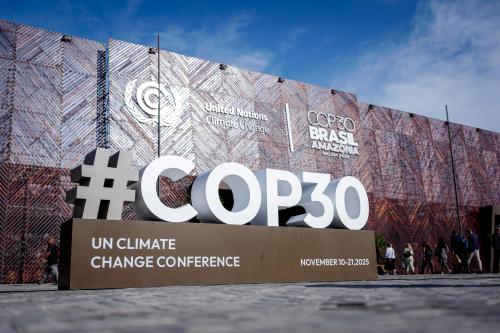As ministers from around the world meet at the 2025 United Nations Climate Change Conference (COP30) in Belém, Brazil, they face not only technical decisions about carbon targets, but deeper political fault lines that must be bridged if collective action is to succeed.
Stopping climate change and biodiversity loss is no longer a question of science or technology—it is a question of governance. The global economy must evolve so that producers and consumers pay for the harm they cause to nature and society and are rewarded for the benefits they create.
Yet behind this simple principle lies a profound challenge: What happens when countries, generations, and communities fundamentally disagree about how to measure those harms and benefits?
That disagreement defines the politics of climate change today. It divides the present from the future, rich countries from poor ones, powerful states from vulnerable ones, and citizens who value the long term from those focused on immediate needs. Finding ways to govern amid these divisions is the defining test for 21st-century policy design.
Ministers attending COP30 must therefore deploy instruments that map to political constituencies, not just ideal economic models.
1. Bridging the generation gap
At COP30—10 years on from the Paris Agreement—the difference in perspective between present and future generations is acute. The host city of Belém, in the Amazon, symbolizes this global legacy.
Economic models differ on how heavily to “discount” the well-being of future people. The Stern Review adopted a low discount rate, arguing for strong, early action; William Nordhaus and others preferred higher rates reflecting private investment returns.
Instead of seeking a single correct number, governments can adopt precautionary and institutional responses. Precautionary principles—like “safe minimum standards” for ecosystems or biodiversity—protect against irreversible losses without assigning them a price tag. Institutional innovations, such as citizens’ assemblies or “offices for future generations,” give voice to those who cannot yet vote.
These mechanisms turn ethical disagreement into democratic deliberation, helping societies act responsibly toward the future without pretending consensus on its exact worth.
Instruments for ministers
- Establish or empower an institutional “office for future generations” (or equivalent) that participates in COP30 negotiations and follows up in national policy.
- Adopt a declining social discount rate (or dual discounting) in national cost-benefit frameworks for long-lived investments such as forests, biodiversity, and infrastructure.
- Embed safe-minimum or precautionary standards for irreversible damages (e.g., rainforest loss, tipping points) instead of relying solely on monetized metrics.
- Channel portions of carbon/pricing revenue into generational trusts or sovereign green funds so that future cohorts visibly benefit.
2. Sharing responsibilities across borders
The divide between rich and poor countries is equally deep. Wealthy nations industrialized first and emitted most of the accumulated carbon now driving global warming. Poorer nations face the dual task of developing economically while avoiding the same path.
The principle of “common but differentiated responsibilities,” embedded in the Paris Agreement, remains the cornerstone of a fair climate regime. The task now is to operationalize it—through predictable climate finance, debt swaps for nature, and technology-sharing arrangements.
Carbon clubs—coalitions of countries linking market access to climate performance—offer a complementary path. Properly designed, such clubs can reward ambition while dedicating a share of revenues to support low-income participants. This combination of incentives and equity is critical to maintaining legitimacy in a multipolar world.
Instruments for ministers
- Operationalize the principle of “common but differentiated responsibilities” (CBDR) through tiered pricing, carbon budget allocations, or special transition support for low-income nations.
- Scale up climate finance, technology transfer, and loss-and-damage mechanisms ahead of or during COP30.
- Use carbon clubs or trade-linked incentives that reward early movers and dedicate part of the revenues to support developing country members.
- Promote debt-for-nature or adaptation-for-concession programs that link climate action and development.
3. Balancing power among nations
Climate diplomacy also reflects global power imbalances. Small island states and least-developed countries bear the brunt of climate impacts but wield little geopolitical leverage.
Rules and institutions can help level the field. International law is beginning to treat climate inaction as a human rights issue, giving vulnerable nations new avenues to hold major emitters accountable.Transparency and standardized reporting under frameworks such as the Task Force on Climate-Related Financial Disclosures (TCFD) also generate reputational and financial pressure on laggards.
In parallel, “minilateral” initiatives—small groups of willing countries advancing faster—can create competitive pressure for others to follow, provided that such clubs include fair access and technical assistance for weaker states.
Instruments for ministers
- Strengthen transparency, mandatory climate-risk disclosure, and accountability mechanisms that increase the reputational costs for powerful states/actors.
- Encourage minilateral “implementation clubs” emerging from COP30 that include smaller states with equitable governance rights and financial/technical backing for weaker members.
- Link market access or green procurement rules (especially for supply chains) to environmental/social performance, enabling smaller states to gain access via compliance.
- Consider treaty-linked legal obligations or dispute-resolution pathways that give weaker states leverage.
4. Reconciling different time preferences
Within and between countries, there is a divide between those who prioritize near-term gains (jobs, energy costs, growth) and those willing to invest for long-term planetary resilience. COP30 must manage both.
Policy design can bridge this divide. Gradually rising carbon prices, coupled with visible rebates or tax swaps, deliver immediate benefits while maintaining the long-term signal for emissions reduction. “No-regret” measures—like improving energy efficiency or restoring degraded ecosystems—benefit both present and future generations.
Scholars such as Martin Weitzman and Robert Pindyck emphasize that climate change involves “fat-tailed” risks—low-probability, high-impact catastrophes. In such cases, mitigation functions as insurance. Societies with high discount rates still have reason to pay premiums against existential threats.
Instruments for ministers
- Emphasize “no-regret” measures (energy efficiency, ecosystem restoration) that deliver immediate local benefits and long-term climate gains.
- Introduce carbon prices that rise steadily and predictably, paired with revenue recycling (rebates, lower other taxes) so present-day constituencies see benefits.
- Frame mitigation strategy as insurance against catastrophic (“fat-tail”) risks rather than purely return-on-investment, appealing to both high- and low-discount groups.
- Use adaptive policy pathways (review mechanisms at COP30) to lock in long-term commitments while allowing near-term flexibility.
5. From consensus to robustness
In many policy domains, disagreement leads to paralysis. But climate policy can move forward by focusing not on perfect consensus, but on robustness.
“Decision making under deep uncertainty” (DMDU), a framework developed by RAND researchers like Robert Lempert, offers a pragmatic approach. Instead of optimizing for one forecast of the future, DMDU stress-tests policies across many plausible scenarios. The goal is to find strategies that perform reasonably well under all of them.
This approach reframes climate governance as adaptive learning, which allows policy design to evolve as information, technologies, and social values change. It is an institutional response to political and ethical pluralism.
6. Policy architecture for a divided world
A realistic climate policy architecture should combine three elements:
- Procedural legitimacy – through deliberative processes, representation of future interests, and transparent trade-offs
- Precaution and safety standards – to manage irreversible risks where valuation fails
- Redistribution and incentive compatibility – to ensure that poorer and weaker actors are compensated for their participation
Such a system doesn’t demand agreement on a universal “social cost of carbon.” It works precisely because it tolerates disagreement yet channels it toward sustained, adaptive action.
In a world that cannot agree on the “price of the planet,” the goal is not perfect valuation but functional governance. Climate policy must be legitimate, precautionary, redistributive, and robust—capable of surviving disagreement, not waiting for it to disappear.
The Brazilian presidency of COP30 emphasizes “implementation and inclusion” as the transition from planning to delivery. Ministers attending Belém must thus deploy instruments that reflect this shift from negotiation of targets to implementation of frameworks that internalize environmental and social costs in politically sustainable ways.
By aligning instruments with political constituencies—future generations, developing countries, weaker states, and those with short- versus long-term preferences—COP30 can become a turning point not only for ambition but for resilience of the global climate regime.
The Brookings Institution is committed to quality, independence, and impact.
We are supported by a diverse array of funders. In line with our values and policies, each Brookings publication represents the sole views of its author(s).



Commentary
How to govern climate policy in a divided world
Robust systems for when we can’t agree on the price of the planet
November 14, 2025